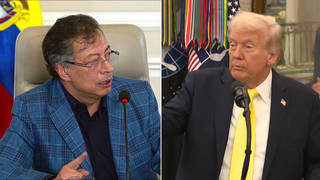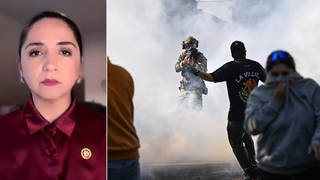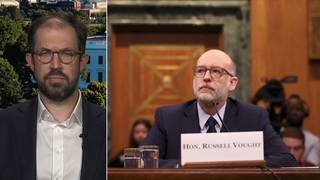
Is the Trump administration attempting to erase history? On Friday, congressional officials confirmed the administration has begun returning to Congress copies of the Senate’s explosive 2014 report on CIA torture. The move raises concerns that copies of the classified report will now be buried in Senate vaults or even destroyed—and, along with it, lessons from one of the darkest chapters in America’s history. Under the Obama administration, the 6,770-page landmark investigative Senate report was initially sent to federal agencies in hopes it would eventually be made public. Now the reports will be returned to the Republican-controlled Senate. Documents held by Congress are not subjected to laws requiring government records to be eventually made public. Democrats are expressing fear that the Trump administration intends to erase electronic copies and destroy hard copies of the report. We speak with Shayana Kadidal, a senior managing attorney at the Center for Constitutional Rights. CCR represents two men named as former CIA prisoners in the executive summary of the Senate torture report released in 2014. Majid Khan and Guled Hassan Duran are both currently held at Guantánamo.
Transcript
NERMEEN SHAIKH: Well, we turn now to another issue. Is the Trump administration attempting to erase history? On Friday, congressional officials confirmed the administration has begun returning to Congress copies of the Senate’s explosive 2014 report on CIA torture. The move raises concerns that copies of the classified report will now be buried in Senate vaults or even destroyed—and, along with it, lessons from one of the darkest chapters in America’s history.
Under the Obama administration, the 6,770-page landmark investigative Senate report was initially sent to federal agencies in the hope it would eventually be made public. Now the reports will be returned to the Republican-controlled Senate. Documents held by Congress are not subjected to laws requiring government records to eventually be made public.
On Friday, The American Civil Liberties Union said in a statement, quote, “It would be a travesty for agencies to return the CIA torture report instead of reading and learning from it, as senators intended. … This critically important investigation should have been made public.”
AMY GOODMAN: Democrats are expressing fear that the Trump administration intends to erase electronic copies and destroy hard copies of the report. In a statement, Democratic Senator Ron Wyden of Oregon accused the Trump administration of seeking to, quote, “pave the way for the kind of falsehoods used to justify an illegal and dangerous torture program,” unquote.
Throughout the campaign and since taking office, President Trump has voiced his support for torture. This is ABC’s David Muir questioning Trump about torture in January.
DAVID MUIR: Mr. President, you told me during one of the debates that you would bring back waterboarding—
PRESIDENT DONALD TRUMP: Yeah.
DAVID MUIR: —and a hell of a lot worse, in your words.
PRESIDENT DONALD TRUMP: I would do—what I would do—I want to keep our country safe. I want to keep our country safe.
DAVID MUIR: What does that mean?
PRESIDENT DONALD TRUMP: When they’re shooting—when they’re chopping off the heads of our people and other people, when they’re chopping off the heads of people because they happen to be a Christian in the Middle East, when ISIS is doing things that nobody has ever heard of since medieval times, would I feel strongly about waterboarding? As far as I’m concerned, we have to fight fire with fire. …
I have spoken, as recently as 24 hours ago, with people at the highest level of intelligence, and I asked them the question: Does it work? Does torture work? And the answer was: “Yes, absolutely.”
AMY GOODMAN: So, that was President Trump speaking to ABC’s David Muir in January. The Freedom of the Press Foundation is now calling for whistleblowers within the Trump administration to contact the press before the Senate torture report is potentially lost forever. The group tweeted, quote, “If you work for the Trump administration and your conscience compels you to blow the whistle, you can use @SecureDrop to contact the press.”
Well, for more, we’re joined—continuing to be joined by Shayana Kadidal, the senior managing editor—senior managing attorney at the Center for Constitutional Rights. CCR represents two men named as former CIA prisoners in the executive summary of the Senate torture report that was released in 2014. Majid Khan and Guled Hassan Duran are both currently held at Guantánamo. So, Shayana, talk about the significance of what the Trump administration is doing with this report.
SHAYANA KADIDAL: Sure. Well, it’s certainly highly significant to individual cases, right? It’s useful to go back a little bit and, I guess, remind ourselves what has been released and what we might still be waiting on, right? So, in December 2014, after many years of struggle with the Obama administration over essentially redaction and classification review of the parts of the report, they released the 525-page executive summary, right? Which shows, among other things, that techniques that were applied were much worse than what was revealed in those torture memos under the Bush administration, right? That it was applied against a lot more people than was previously discussed, and that group of people included at least 26 people who were wrongly suspected of involvement in terrorism, basically, right? Against people who were, quote-unquote, “innocent,” right? That it—that the techniques exceeded the legal authorization that was spelled out in those memos, and that, finally, really nothing productive came out of the torture and detention program, right? That there wasn’t actionable intelligence that came out of it, and that there wasn’t cooperation induced among detainees, right?
And that bottom line is, I think, the most important thing that probably remains to be reinforced by the 6,000-plus pages that haven’t been released, that haven’t been redacted into unclassified form and released publicly, right? We only know this because of what Senator Feinstein has said, but she says that the remaining portion of the report that Senator Burr is trying to bury, that the agencies are returning, contains a great deal more detail about the ineffectiveness of the program, how it didn’t produce useful intelligence like the CIA claimed, and it responds in great detail to the CIA’s own defense of the program.
Then, on top of that, we also know from Feinstein’s cover letter to the executive summary that there are detailed chapters, essentially, on all of the 119 detainees. So this might be very useful in their individual cases, certainly might be useful in the sentencing proceeding of our client, Majid Khan, who cut a plea and cooperate agreement, and potentially in the habeas corpus case, arguing for his freedom, for Guled Hassan Duran, our other client in the CIA program.
NERMEEN SHAIKH: Well, Burr is a longtime critic of the report, which he’s described as disreputable and overly critical of the CIA and the Bush, George W. Bush, administration. At one point, he called the report nothing more than, quote, “a footnote in history.” So, could you explain why you think the Republicans are so averse to releasing this report and what, you know, we can speculate is in the report that might be particularly critical of them?
SHAYANA KADIDAL: Right, it’s the million-dollar question, right? I mean, this is a, you know, 6,000-plus-page footnote. It was the product of five years of intensive labor by Senate staffers. The Senate Intelligence Committee voted almost unanimously to conduct the inquiry, 14 to one, in 2005, when the whole thing got started, right? So, it’s really mysterious, you know, why they want to bury it. And I think the only clue that we really have to it is what Feinstein has said about what’s in there, which is precisely that it undercuts the CIA’s argument that the program was somehow effective in producing intelligence, in disrupting active terrorist threats and helping find Osama bin Laden.
And, you know, obviously, with the Republican president out there extolling the virtues of torture once again, in a way that would have seemed remarkable during the 2008 campaign, when both John McCain and Senator Obama were saying that we needed to kind of move on from it, it’s, I think, pretty clear that this is—this is simply a partisan attempt to make sure that the public isn’t exposed to the idea that torture doesn’t work, right? Which polling data, remarkably, shows most people haven’t even heard that, that statement. They haven’t heard that argument.
NERMEEN SHAIKH: Is there any chance, do you think, given this opposition, that the report may eventually be released, or is it now a foregone conclusion that it won’t?
SHAYANA KADIDAL: Well, so, no. There are four copies that are apparently being returned, all from intelligence agencies, basically—the FBI, two copies from the CIA and the director of national intelligence’s copy. But there are three copies that are still out there, outside of the Senate’s copies, right? One is with President Obama’s National Archives presidential records. That can’t be released, by law, I think, until 2028. But that one’s safe for now. Then there are two others that are being held pursuant to court preservation orders, because they might be important to cases, one from the military commissions and one from the habeas cases. So those will still be out there. But, you know, it’s obviously very difficult to get any record like this declassified. It took four years just to get that executive summary out under President Obama. So, it’s a long, long struggle. And, you know, I think one key point that you mentioned at the outset is, we want the agencies to read this, so that they learn from it and so that it never happens again.
AMY GOODMAN: WikiLeaks founder Julian Assange tweeted, “Trump, threatened by #resistance-CIA alliance, gives CIA concessions from prosecuting WikiLeaks to hiding torture.” Your response?
SHAYANA KADIDAL: Well, I don’t think, you know, Trump needed to make concessions. You know, his statements about torture seem sort of crazy when we think back to the bipartisan consensus against it at earlier times. But, you know, he may be crazy like a fox here. The polling data, since the middle of the Bush administration, shows consistently two things: one, that the public is unfamiliar with the idea that torture doesn’t work, and, second, that evangelicals strongly support torture, not because they think it works, but because they think it’s justified punishment. And there, when you understand that, you understand the kind of evil genius of Trump’s campaign statement, that, sure, it works, and even if it doesn’t work, they deserved it anyway.












Media Options